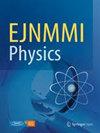Bone marrow dosimetry in low volume mHSPC patients receiving Lu-177-PSMA therapy using SPECT/CT
IF 3
2区 医学
Q2 RADIOLOGY, NUCLEAR MEDICINE & MEDICAL IMAGING
引用次数: 0
Abstract
Bone marrow toxicity in advanced prostate cancer patients who receive [177Lu]Lu-PSMA-617 is a well-known concern. In early stage patients; e.g. low volume metastatic hormone sensitive prostate cancer (mHSPC) patients, prevention of late bone marrow toxicity is even more crucial due to longer life expectancy. To date, bone marrow dosimetry is primarily performed using blood sampling. This method is time consuming and does not account for possible active bone marrow uptake. Therefore other methodologies are investigated. We calculated the bone marrow absorbed dose for [177Lu]Lu-PSMA-617 in mHSPC patients using SPECT/CT imaging and compared it to the blood sampling method as reference. Eight mHSPC patients underwent two cycles (3 and 6 GBq) of [177Lu]Lu-PSMA-617 therapy. After each cycle, five time point (1 h, 1 day, 2 days, 3 days, 7 days) SPECT/CT was performed at kidney level. Bone marrow dosimetry was performed using commercial software by drawing ten 1.5 cm diameter spheres in the lowest ten vertebrae to determine the time-integrated activity. Simplified protocols using only 2 imaging time points and 3 vertebrae were also compared. Blood-based dosimetry was based on the blood sampling method according to the EANM guideline. Mean bone marrow absorbed dose was significantly different (p < 0.01) for the imaging based method (25.4 ± 8.7 mGy/GBq) and the blood based method (17.2 ± 3.4 mGy/GBq), with an increasing absorbed dose ratio between both methods over time. Bland Altman analysis of both simplification steps showed that differences in absorbed dose were all within the 95% limits of agreement. This study showed that bone marrow absorbed dose after [177Lu]Lu-PSMA-617 can be determined using an imaging-based method of the lower vertebrae, and simplified using 2 time points (1 and 7 days) and 3 vertebrae. An increasing absorbed dose ratio over time between the imaging-based method and blood-based method suggests that there might be specific bone marrow binding of [177Lu]Lu-PSMA-617.利用 SPECT/CT 对接受 Lu-177-PSMA 治疗的低容量 mHSPC 患者进行骨髓剂量测定
接受[177Lu]Lu-PSMA-617治疗的晚期前列腺癌患者的骨髓毒性是众所周知的问题。对于早期患者,如低体积转移性激素敏感性前列腺癌(mHSPC)患者,由于预期寿命较长,预防晚期骨髓毒性更为重要。迄今为止,骨髓剂量测定主要通过血液采样进行。这种方法耗时较长,而且无法考虑骨髓可能的活性吸收。因此,我们研究了其他方法。我们利用SPECT/CT成像技术计算了mHSPC患者骨髓对[177Lu]Lu-PSMA-617的吸收剂量,并将其与血液采样法作为参考进行了比较。八名 mHSPC 患者接受了两个周期(3 和 6 GBq)的 [177Lu]Lu-PSMA-617 治疗。每个周期结束后,在肾脏水平进行五个时间点(1 小时、1 天、2 天、3 天、7 天)的 SPECT/CT 检测。使用商业软件进行骨髓剂量测定,在最低的十个椎骨上绘制十个直径为 1.5 厘米的球体,以确定时间积分活性。此外,还比较了仅使用 2 个成像时间点和 3 个椎骨的简化方案。血液剂量测定是根据 EANM 指南采用血液采样法进行的。基于成像的方法(25.4 ± 8.7 mGy/GBq)和基于血液的方法(17.2 ± 3.4 mGy/GBq)的平均骨髓吸收剂量有显著差异(p < 0.01),且随着时间的推移,两种方法的吸收剂量比不断增加。对两种简化步骤进行的布兰德-阿尔特曼分析表明,吸收剂量的差异均在 95% 的一致范围内。这项研究表明,[177Lu]Lu-PSMA-617 后的骨髓吸收剂量可通过基于下椎体成像的方法确定,并可通过 2 个时间点(1 天和 7 天)和 3 个椎体进行简化。基于成像的方法和基于血液的方法的吸收剂量比值随着时间的推移而增加,这表明[177Lu]Lu-PSMA-617 可能存在特异性骨髓结合。
本文章由计算机程序翻译,如有差异,请以英文原文为准。
求助全文
约1分钟内获得全文
求助全文
来源期刊

EJNMMI Physics
Physics and Astronomy-Radiation
CiteScore
6.70
自引率
10.00%
发文量
78
审稿时长
13 weeks
期刊介绍:
EJNMMI Physics is an international platform for scientists, users and adopters of nuclear medicine with a particular interest in physics matters. As a companion journal to the European Journal of Nuclear Medicine and Molecular Imaging, this journal has a multi-disciplinary approach and welcomes original materials and studies with a focus on applied physics and mathematics as well as imaging systems engineering and prototyping in nuclear medicine. This includes physics-driven approaches or algorithms supported by physics that foster early clinical adoption of nuclear medicine imaging and therapy.
 求助内容:
求助内容: 应助结果提醒方式:
应助结果提醒方式:


